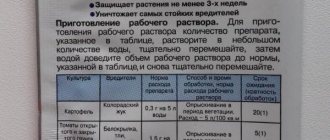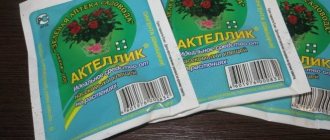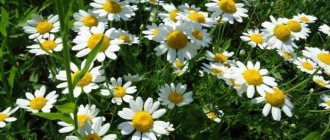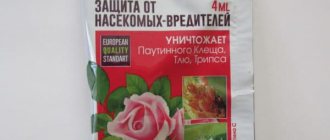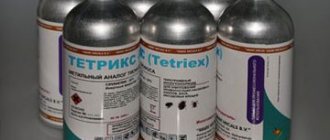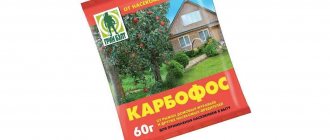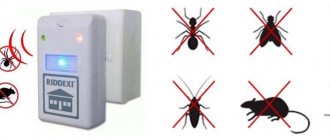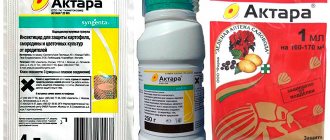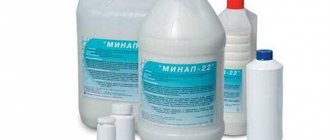What is tobacco dust
The dust is produced from waste from tobacco production. This is a light brown powder, which is obtained by drying and grinding the raw materials. It has insecticidal properties and can be an excellent natural fertilizer. All methods of using tobacco powder show good results.
The active ingredient in the dust is nicotine, which is found in tobacco. In drugs that produce chemicals. enterprises, the concentration differs slightly. For example, in the product from JSC Kostroma Chemical Plant, nicotine is in a concentration of 12 g per kg. It has both intestinal and contact effects on pests.
Garlic tincture
Garlic is used against kidney and spider mites, aphids, whiteflies and some herbivorous caterpillars.
The infusion is prepared from 0.4 kg of chopped garlic and a bucket of water. After thorough stirring, cover the container and put it in a dark corner. After 5-6 hours, 1 liter of infusion is added to a bucket of water and the bushes are sprayed.
Another way to make an infusion to protect blackcurrants from pests: chop 200 g of the spicy vegetable and dilute with boiling water (4 l). Leave for 1 week. Add a quarter of a glass of this infusion to a bucket.
The use of tobacco dust against pests
Tobacco powder can be used as a means for dusting and fumigating plants, and prepare infusions and decoctions based on it. They can be used in outdoor garden beds and greenhouses.
The powder is also used as a fertilizer, simply sprinkled on the surface of the soil near plants or introduced into the ground.
Decoction for spraying
Preparation procedure: pour 500 g of powder into 10 liters of hot water, boil for half an hour. Leave for 1 day, filter, add the evaporated volume of water, add 40 g of soap shavings.
The decoction is used for spraying cabbage and cruciferous vegetables, flowers, berry bushes and fruit trees. For work in the garden and garden, prepare a decoction in a concentration of 1 to 10. Application rate and consumption:
- cabbage, cruciferous vegetables, flowers from fleas, whites, moths, flies and aphids - 500 g/100 m2 (5 l/100 m2);
- bushes against aphids - 500 g/5 l (1-1.5 l/bush);
- fruit from aphids and honey beetles - 500 g/5 l of water (from 2 to 10 l/tree (the volume used is affected by the age and variety of the plant)).
Frequency of treatments – 3 (with a break of a week and a half), waiting period – 20 days.
Infusion for berry trees
The infusion can be prepared and used in the same way as a decoction. It has the same effect and is prepared in the same concentration. The difference between a decoction and an infusion is that hot water is used to prepare the first, and cold water for the second. Leave the infusion for 1 day, filter and add soap for adhesion.
See also
Rules for using dolomite flour and composition, consumption and how to apply fertilizerRead
Wood ash mixture
Tobacco dust is used in gardening not only in its pure form, but also in a mixture with pure ash from burning tree branches and plant residues. The two components are mixed in a 1 to 1 ratio and mixed well.
For 1 sq. m of plantings will require 10-20 g of mixture. It is applied by dusting to plants. A thin layer covers the entire surface of the leaves, making it difficult for pests to feed.
As a result, they are left without food and die. The tobacco-ash mixture can be used to treat crops in garden beds and in greenhouse conditions. It acts not only against aphids and other insects, but snails and slugs are afraid of it. Against them, the mixture is sprinkled on paths, row spacing and the area around plants - places where mollusks can move. You need to scatter the powder in the evening, before the pests become active. Several sprays may be needed to repel pests.
Dusting plants
For dusting, use pure powder. They powder all parts of plants: cabbage, radishes, radishes, and onions.
Application rate:
- fly onion – 300 g/100 m2;
- cabbage and cruciferous vegetables against flea beetles, whites, moths, flies and aphids – 500 g/100 m2.
The frequency of dusting is 2 times for onions, for other crops – 3 times. The break between treatments is 7-10 days. The waiting period is 20 days.
Tree fumigation
Fruit trees are fumigated after flowering has ended. While the trees are blooming, the smoke will harm the bees. Fumigation process: set fire to wood or branches, sprinkle dust on the coals. Add more as needed to keep the smoke flowing continuously. Processing time: from 30 min. Carry out the work when the wind is blowing towards the trees.
Expert opinion
Zarechny Maxim Valerievich
Agronomist with 12 years of experience. Our best country expert.
Ask a Question
Fumigation can also be carried out in a greenhouse. This is how aphids and whiteflies are destroyed. For 1 cu. m. volume is enough 10 g of powder.
How to get rid of indoor plants at home?
There are several methods to combat this dangerous pest.
You can choose one or combine several, depending on the scale of the problem. There are 2 groups of methods on how to fight and defeat aphids:
- mechanical;
- chemical.
Mechanical method
The first consists of manual pest removal. It does not require financial investments. Plants should be inspected regularly to prevent mass reproduction.
A number of conditions must be met:
- availability of time;
- patience;
- no feeling of disgust.
The method is suitable if the aphids have not yet had time to reproduce. You can collect insects by hand only at the initial stage of infection.
Chemical method
The chemical method involves the use of special products designed to kill aphids. Each of them comes with instructions with a detailed plan.
Important! The poisons are so strong that they can solve the problem the first time.
Popular means for killing aphids are:
- "Aktara";
- "Intra-vir";
- "Karate";
- "Face";
- "Hostakvik".
They contain synthetic insecticides. The preparations are suitable for treating plants indoors. The preparations need to be changed from time to time, since the aphids become immune to the chemicals.
Precautions to be taken:
- wear gloves;
- use a respirator;
- ventilate the room;
- During processing, isolate animals and family members.
The dosage of the drug and method of use are described in the instructions. Chemicals should be used as a last resort.
It is recommended to spray ornamental crops 40 days before harvest. Indoor plants are treated before the flowering phase begins.
Folk remedies
You can fight an aphid infestation using available means. They are no less effective than chemicals.
- Ammonia. The product is diluted with water (1:1) and sprayed on the plants. Repeated treatment should be carried out after 4 days.
- Soap solution. To prepare the product you will need 5 liters of water, 1 tbsp. l. ammonia, a few drops of shampoo or soap. Mix all ingredients and spray on plants.
- Onion peel. Throw a pinch of husk into a container of boiling water (1 liter) and cook for 5 minutes. Then the composition is infused for another day, filtered, and the plants are sprayed with the finished product. The product is especially effective for controlling pests on tomatoes and indoor flowers.
- Vinegar. To prepare the solution, dilute 1 tbsp in 1 liter of water. 9% acetic acid. The spraying procedure should be repeated every 4-5 days until the pest dies.
- Citrus peel. Boil orange or lemon skins. You need 1 handful per 1 liter. water. The broth is cooled, left for 3 days, then filtered. Plants are treated with the prepared product. You can simply put citrus peels in a flower pot.
- Tobacco. There are 2 ways to use tobacco. You can simply sprinkle it on the leaves and soil, or prepare an infusion. For 1 tbsp. boiling water take 1 tbsp. shag. The composition is infused for 2 days, then filtered and sprayed on the plants.
- Celandine. A glass of crushed leaves is poured into 1 liter. water. They insist and filter. The product is suitable for treating indoor and outdoor plants. If necessary, repeat the procedure after a week.
Reference! The main advantage of traditional methods is their absolute safety for animals and children.
How to deal with pests on an orchid?
There are 2 ways to destroy a pest on an orchid: chemical and folk. The latter helps solve the problem at the initial stage. It is recommended to treat the plant with soap solution, citrus peels, and onion infusion.
An effective remedy for pests is rosehip solution. The fruits (15 g) are soaked in warm water (1 liter), left for a day, then boiled for half an hour. The flowers are sprayed with the prepared solution.
After treatment, you should wait 2 weeks and observe the plant. If the insect does not die, you should resort to chemical means. The break between treatments should be 2 weeks. The same drug is not used more than 3 times.
Use as fertilizer
Tobacco dust contains mineral elements that plants need. Its chemical composition accelerates plant growth, improves the quantity and quality of fruits. The powder can be applied to the soil during its preparation, during sowing or planting crops.
See also
Instructions for use and composition of Aquarin, fertilizer dosage and analoguesRead
So, for example, when planting trees or shrubs, add 1 or 2 cups of dust to each planting hole. When preparing land for planting vegetables or sowing lawn grasses for each square. m. add 20 g of the drug. To ensure uniform distribution of the powder in the soil, the soil must be thoroughly mixed after application. When used in spring, it is recommended to add dust to nitrogen-containing fertilizers. When applied in the fall, add to potash mixtures.
You can use tobacco dust not only as a top dressing, but also as a main fertilizer. Application should be done less frequently - once every 3 seasons, but with an increased amount of product - 40 g per square meter. m.
If tobacco dust is used to feed indoor flowers, then it is added to the substrate in a volume of 0.5 tsp. per 10 liters of soil. The mixture is filled into pots when replanting plants.
Rules for processing shrubs
To achieve maximum results from preventive treatment, it is important not only to accurately observe the dosage when preparing the solution, but also to correctly carry out the procedure itself. Time, the stage of plant development, as well as weather conditions should be taken into account. To carry out spraying, you will need specialized tools and protective equipment, which must be prepared in advance.
Processing times
All work on caring for plants in the garden is based on the natural cycle of plant development. Currants have a clear growing season and dormancy, the onset of which depends on the climate, variety and age of the bush. Before starting any preventive measures, it is recommended to carefully inspect the bush, prune it and take into account the weather forecast for the next 10 days.
In early spring
You can treat your garden from diseases and pests almost immediately after the snow melts. First of all, they use strong methods that can cause damage to the plant - watering the tree trunk with boiling water, treating with ammonia and stinging. It is recommended to spray the bush using traditional methods before active swelling of the buds on the shoots begins, which helps avoid the spread of ticks. The second mandatory treatment should occur at the beginning of flowering. Then the procedures are repeated after 10-14 days. Find out how to treat brown spots on currant leaves at this link.
In summer
Most harmful insects are activated after warming, as well as at the time of currant flowering. This is due to the beginning of the movement of juice in the shoots, which is important for their nutrition. In summer, treatment with home remedies is carried out until late autumn. Traditional methods do not harm the plant, nor do they impair the quality of the crop. Preventive spraying is carried out twice a month; it is recommended to alternate the products to achieve a lasting result. Mandatory stages for work are the flowering period, the beginning of the formation of ovaries and the entire period of mass fruiting.
When growing varieties that require pollination at the time of flowering, it is recommended to temporarily refrain from cultivating the garden. Biological insecticides can reduce summer activity and the number of beneficial insects.
Tools
To process the garden and prepare the working solution, you may need quite a few different tools. It is recommended to prepare them in advance, especially when growing currants in the first year. Important accessories:
- protective equipment - gloves, boots and a respiratory mask;
- metal containers with a volume of 8, 10 and 12 l;
- measuring cup and scales;
- spray;
- watering can with different dispersion modes;
- sieve or fine mesh for straining;
- smoke generator for fumigation.
The simplest processing method is dusting. It is carried out by hand without the use of special tools. Some gardeners use plastic bottles with holes drilled in them to evenly distribute the dry powder.
Technology
There are several ways to treat garden plants against infection by insects and diseases. Basic preventive methods:
- Root application . This is the usual watering of shrubs using a watering can with fine dispersion. The solution is used to treat the entire area of the tree trunk circle, as well as the row spacing. The method is especially effective against larvae overwintering in the soil, ants and mole crickets, and root nematodes.
- Foliar application . It is dusting, spraying or fumigating bushes. As a rule, the working solution is prepared with a lower concentration to avoid damage to the leaves when the product gets on them. It is used to prevent infection of almost all herbivorous insects.
For comprehensive protection of shrubs, it is recommended to combine both methods. This allows you to increase the stability of the green parts and roots of the plant. Usually the methods are alternated using different means.
Mistakes made by new gardeners
Homemade treatments are mildly toxic and safe for plants. Inexperienced gardeners can make mistakes that lead to a deterioration in the health of the bush and depletion of the soil. Common violations:
- incorrect choice of water temperature for preparing the solution;
- non-compliance with the dosage, especially when working with strong substances (ammonium, mustard powder, vinegar);
- frequent treatment, simultaneous use of chemical and household insecticides;
- earlier work;
- use of expired components, violation of storage and preparation regime.
It is important to choose the right application method. If necessary, use personal protective equipment.
Precautionary measures
Tobacco dust can irritate the respiratory system and eyes. To prevent the powder from getting into the nose and eyes, you need to prepare a solution, and even more so, dust the plants - wearing a respirator or a gauze bandage and glasses. Wear rubber gloves on your hands to protect your skin from the irritating effects of the drug.
If tobacco dust gets on the mucous membranes of the nose and mouth, you should immediately rinse them with clean water. Powder poisoning is rare; in terms of toxicity, it belongs to class 3, that is, to low-hazard agricultural products.
Tobacco dust is a natural insecticide that can be used on private farms to treat trees, shrubs, and vegetable plants against common pests. In addition to its naturalness and, as a result, safety, the drug has many advantages: it works effectively, insects do not get used to it. It is very convenient to use, it is cheap, accessible, and if stored in a dry place, it can be stored for a long time (2 years in a closed package, 1 year in a loosely closed package).
Of course, in terms of effectiveness against pests, tobacco dust is inferior to synthetic insecticides, so you will have to carry out not one, but several treatments. But the products will be environmentally friendly.
When used as a fertilizer, dust helps reduce the cost of purchasing fertilizers and makes growing vegetables and fruits more profitable. The product does not contain harmful or toxic substances or pathogens, increases soil fertility, but does not accumulate in it. This makes it a universal natural fertilizer.
Signs of plant damage by aphids
Signs of a plant being affected by aphids are as follows: the leaves literally stick together, curl, turn yellow, the flowers do not bloom or even fall off. The plant is covered with liquid sugary clots. In addition, if an aphid appears, then its companions - ants - will appear behind it. And in reverse order: if you have ants, then aphids will soon appear.
How to protect plants from aphids? Prevent ants from breeding. And often aphids “enter” a house on a bouquet of roses or chrysanthemums. Therefore, do not place bouquets close to indoor plants. The cause of a total epidemic can be a single female flying through a slightly open window or balcony.
Spray technologies
In gardening, mechanized or manual spraying of bushes is used. On private plots, only the second method is used, since it only requires a watering can and a sprayer. During the procedure, it is important not only to follow safety rules, but also deadlines, since untimely processing can lead to the most unpleasant consequences.
Which tools to use
To carry out a complete treatment of currant planting with folk remedies, you will need:
- sprayer or atomizer with dispersion regulator;
- protective suit;
- glasses or mask;
- disposable or rubber gloves;
- boots;
- respirator.
In addition, to prepare folk remedies, you may need a 10-liter metal bucket, scales for measuring the weight of ingredients, and a mixing tool.
Almost all recipes for folk remedies for spring processing involve an infusion process, so the bucket for their creation must have a lid.
Rules
To enhance the effect of the treatment without causing harm to yourself and the plant, you should follow simple rules of procedure:
- work only with protective gloves, a respirator and a mask;
- follow the preparation technology, dosage and infusion time;
- The infusion cannot be used if it is stored for more than 24-48 hours. Folk remedies should be stored in a cool and dark place;
- if vinegar or ammonia gets on exposed parts of the body, rinse the area with plenty of water;
- The processing time must be strictly observed; work cannot be carried out after the buds have begun to open.
Almost all folk remedies for currant processing are enhanced by adding a solution of copper sulfate or quicklime. This will allow you to quickly get rid of insects and also additionally feed the plant.
Deadlines
The time for preventive treatment completely depends on the climate and the region where the currants are planted. First of all, you need to focus on the time of snow melting. You need to start work immediately after this moment. In the south of the country, this usually occurs from the second ten days of April; in the northern regions and Siberia, processing is carried out later - until the end of May.
You cannot process the plant after the buds begin to swell - this leads to a decrease in the growth rate of currants and a deterioration in yield.
conclusions
- Traditional methods of processing currants in spring reduce the risk of developing pests and infections.
- To create the products, simple ingredients that are found in any home are used. These are vinegar, laundry soap, mustard powder and others.
- It is recommended to carry out the procedure 2-3 times with an interval of 3-7 days to reduce the number of insects.
- For processing, you should have personal protective equipment, a spray bottle or sprayer, a watering can and a bucket.
- Currant processing in the spring is carried out after the snow has melted on the site. The specific time for the work depends on the climate in the region. The procedure begins in April-May.
This material will tell you how to protect currants from aphids.
The essence of the fumigation process: description and characteristics of the method
Fumigation is a complex treatment of garden plantings and topsoil with smoke from a fire. The immediate purpose of garden waste burning with this method is not to destroy fallen leaves, trimmed branches and garden debris. Each gardener pursues a different desire - to obtain the maximum amount of smoke, full of natural insecticidal compounds that can disinfect plants and destroy both adult pests and their larvae.
To achieve this goal, the base of the fire must consist of moistened ingredients. You can use wet straw, sawdust, fallen leaves, peat or weed clippings. There will be no fire from such components of the fire, but there will be a lot of smoke, and such a fire will smolder for a long time, ensuring high-quality processing.
Next, additional material is laid on the damp, steaming base, which, when heated, releases a specific odor that radically repels insect pests. Such smoke is quite capable of killing not only adult insects, but also their larvae.
Are there any contraindications
Folk remedies for treating pests are considered the most environmentally safe and harmless, in contrast to synthetic drugs. However, if the dosage and technology are not observed, irreparable harm to the plant and soil can be caused. This point especially applies to the treatment of currants with ammonia, vinegar essence and soap. If you overdose with these substances, you can disrupt the acidity level of the soil, and if you use ammonia, you can oversaturate the soil with nitrogen. In addition, these substances can be dangerous to humans if they come into contact with mucous membranes or the esophagus.
How to repel blackcurrant moth
If cobwebs appear on the berries, they dry out and crumble, it’s time to place buckets or basins between the bushes where elderberry or tomato branches are soaked. Sand will also help if you pour kerosene into it. Some gardeners plant tomato bushes next to currants or between bushes. It is useful to repel with the smell of marigolds, catnip, lemon balm, and coriander.
For spraying, the same means are used as in the fight against aphids.
When the caterpillars are about to pupate, the under bushes need to be loosened and sprinkled with a dry mixture. To a glass of tobacco dust, add ash - 1.5 cups and pepper and mustard, 1 spoon each.
Conclusion
To harvest high-quality currant berries, it is worth observing processing times and choosing the right preparations. Instead of harmful chemicals, pests can be controlled using products invented and tested by gardeners.
Fighting shoot aphids
This pest does not like the smoke from burning rubber. It will take 3 hours to maintain the smoldering of rubber objects in metal containers standing next to the bushes.
The solutions listed above will also help. It is useful to infuse pine or spruce needles. For 2 liters of boiling water, 1 cup of pine needles is enough. The product is ready in 5 days, which is diluted with two buckets of clean water.
Green potato tops (1 kg) are filled with water and left for 4 hours. After squeezing out the tops, strain the infusion.
Mustard against moths, aphids and glass beetles on black currants
The product is dusted or sprayed. To prepare the solution, pour dry powder (200 g) into a bucket of water and leave for 2 days.
For spraying, take 1 part of the solution, clean water - 5 parts and laundry soap, 40 g. It is not recommended to process during wind or wet weather.
It is useful to grow white or yellow mustard next to currants.
Fufanon
Fufanon is a systemic anti-aphid drug that penetrates the insect’s body through its skin and esophagus, thereby depriving it of a chance to survive. It is produced in the form of an emulsion, which contains malathion, a new generation insecticide belonging to the class of low-toxic substances. However, its improper use can cause poisoning.
Exposure to toxic particles begins already during spraying. The maximum effect of the drug can be observed the very next day, and therefore there is no need for repeated treatment.
The price of a bottle (1 liter) is about 900 rubles.
